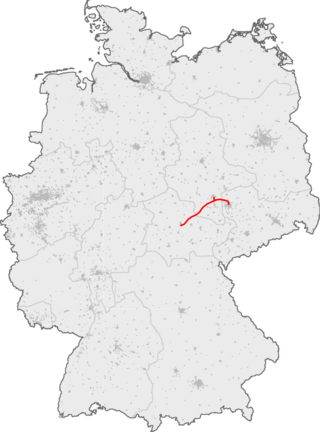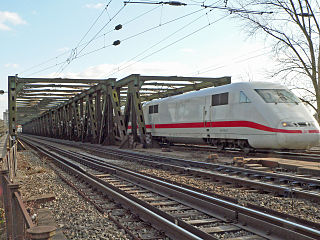
The Deutsche Bahn AG is the national railway company of Germany, and a state-owned enterprise under the control of the German government. Headquartered in the Bahntower in Berlin, it is a joint-stock company (AG) and the largest railway company in the world.

The Deutsche Reichsbahn, also known as the German National Railway, the German State Railway, German Reich Railway, and the German Imperial Railway, was the German national railway system created after the end of World War I from the regional railways of the individual states of the German Empire. The Deutsche Reichsbahn has been described as "the largest enterprise in the capitalist world in the years between 1920 and 1932"; nevertheless, its importance "arises primarily from the fact that the Reichsbahn was at the center of events in a period of great turmoil in German history".

The Federal Network Agency is the German regulatory office for electricity, gas, telecommunications, post and railway markets. It is a federal agency of the Federal Ministry for Economic Affairs and Climate Action and headquartered in Bonn, Germany.

The Intercity Experimental, later renamed ICE V, was an experimental train developed by the Deutsche Bundesbahn for research into high-speed rail in Germany. It is the predecessor of all Intercity Express trains of the Deutsche Bahn.

The Hanover–Würzburg high-speed railway is a double-track, electrified high-speed railway between Hanover and Würzburg in Germany, 327 km (203 mi) in length. The line, built between 1973 and 1991, was the longest contiguous new project constructed by Deutsche Bundesbahn. The total costs were almost DM 11.9 billion.

The Nuremberg–Ingolstadt high-speed railway is a 78-kilometre-long (48 mi) high-speed railway running between the cities of Nuremberg and Ingolstadt in Bavaria, Germany. It branches off the Nuremberg–Regensburg railway and runs parallel to the A9 Autobahn to Ingolstadt, where it joins the Munich–Treuchtlingen railway at Ingolstadt Nord station.

Mannheim–Frankfurt railway is a German standard gauge, electrified railway line and runs in southern Hesse and northern Baden-Württemberg between Frankfurt and Mannheim. It is also called the Riedbahn. The line runs through an area called the Hessische Ried, hence the name. The term Riedbahn was originally used for the Darmstadt–Worms railway and the two lines share the central section between Groß-Gerau and Biblis.
The Nuremberg–Erfurt high-speed railway is a 191-kilometre-long (119 mi) German high-speed railway, between Nuremberg and Erfurt. The line is listed in Germany's federal transport plan as Verkehrsprojekt Deutsche Einheit Nr.8.1 and is a section of the high-speed route between Berlin and Munich and a section of the line connecting Italy and Scandinavia in the European Union's Trans-European Rail network. It consists of an upgraded line between Nuremberg and Ebensfeld and a new line between Ebensfeld and Erfurt. The journey time between Erfurt and Nuremberg will be reduced to approximately one hour and 20 minutes after completion.

The Erfurt–Leipzig/Halle high-speed railway is a 123 km (76 mi)-long high-speed line in Germany between Erfurt and Leipzig and Halle, built as part of the Berlin–Munich high-speed railway.

The Frankfurt–Mannheim high-speed railway is a planned German high-speed railway between Frankfurt am Main and Mannheim.
In Germany and Austria, the running of railway services for a railway administration or the regional network of a large railway company was devolved to railway divisions, variously known as Eisenbahndirektionen (ED), Bundesbahndirektionen (BD) or Reichsbahndirektionen (RBD/Rbd). Their organisation was determined by the railway company concerned or by the state railway and, in the German-speaking lands at least, they formed the intermediate authorities and regional management organisations within the state railway administration's hierarchy. On the formation of the Deutsche Bahn AG in 1994 the system of railway divisions (Eisenbahndirektionen) in Germany was discontinued and their tasks were transferred to new "business areas".

These DB Class V 100 diesel locomotives were produced in the late 1950s by the Deutsche Bundesbahn for non-electrified branch lines as a replacement for steam locomotives. The V 100 class was built in three different variants.
DB AutoZug GmbH was a German rail transport company that provided automobile (Motorail) and night passenger train services for Deutsche Bahn AG. It was based in Dortmund and was a wholly owned subsidiary of Deutsche Bahn AG. On 30 September 2013 the company was merged into DB AG's long-distance division DB Fernverkehr.
The Frankfurt Airport loop is a 15.8-kilometre-long (9.8 mi) double-track railway line connecting Frankfurt and Frankfurt Airport and operated as part of the Frankfurt S-Bahn. It is electrified at 15 kV/16.7 Hz.

The Frankfurt–Göttingen railway is a continuously double track and electrified main line in Hesse and southern Lower Saxony, Germany. The line was initially built from Bebra towards Fulda by the Kurhessen State Railway. After the Prussian annexation of the Electorate of Hesse as a result of the Austro-Prussian War of 1866, it was completed to Frankfurt as the Frankfurt-Bebra Railway. The line was later extended from Bebra to Göttingen.

The Nuremberg–Würzburg Railway is a German trunk line railway in northern Bavaria, connecting the city of Nuremberg with Würzburg, the two largest cities in Franconia, and passing through Fürth, Neustadt an der Aisch and Kitzingen. In addition to hourly Regional-Express trains and numerous freight trains, it is served by Intercity-Express trains during the day at half-hourly intervals with some gaps.

The Federal Authority for Railway Accident Investigation is an agency of the Government of Germany established in 2017 and charged with investigating rail accidents. Its head office is in the Federal Ministry of Transport and Digital Infrastructure (BMVI) Robert-Schuman-Platz 1 office building in Bonn.

The Karlsruhe–Basel high-speed railway is a new line being built on the route of the Mannheim–Karlsruhe–Basel railway. As a result of the project, the railway through the Rhine Valley is being upgraded to four continuous tracks and its operational efficiency will be increased as a result of the segregation of the various transport flows. The travel time for passenger services between Karlsruhe and Basel is to be shortened by 31 minutes. The project forms part of the Rotterdam–Genoa corridor and part of it is also part of the Main line for Europe. In September 2010, it was forecast to be completed in 2020.
The German Centre for Rail Traffic Research is an independent, technical-scientific departmental research institution of the Federal Government. It was founded on May 23, 2019, and is located as an independent federal institute at the Eisenbahn-Bundesamt. Its mission is to strengthen rail transport in Germany through application and solution-oriented research.
















